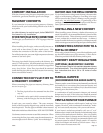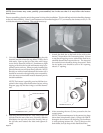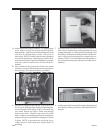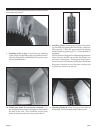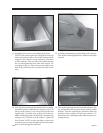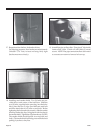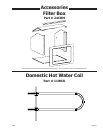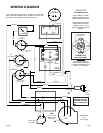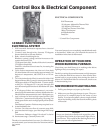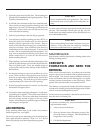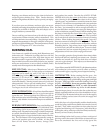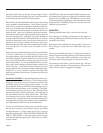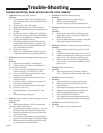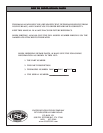
USSC Page 23
Keeping your chimney and stove pipe clean is the best in-
surance against chimney fires. Note: Smoke detectors
and fire extinguishers should always be a part of your equip-
ment.
If you clean your own chimney and stove pipe, we recom-
mended purchasing the equipment professionals use. Wire
brushes are available in enough sizes and shapes to be a
snug fit inside any common flue.
Once a week let your furnace burn with ash door open for
a maximum of fifteen minutes while in attendance. This
will help minimize creosote buildup. Also placing a surface
magnetic thermometer on flue pipe is helpful to keep tem-
peratures at 300 to 400 degrees. Duct temperatures should
be 115 to 125 degrees at 12" above furnace.
BURNING COAL
Your furnace is capable of burning both Bituminous and
Anthracite coal. Anthracite is perhaps the best coal fuel
because its long even burn time, high heat output, and
cleanliness make it a good choice for the home. However,
keep in mind it is a much more difficult fuel to use, requires
more care and patience, is not so widely available, and is
usually much more expensive than bituminous.
SIZE OF COAL: Most sizes of Bituminous Coal will
work in your New Furnace, for best results we recommend
large
nut coal to small egg coal (1-3/4" dia. to 4" dia.).
When burning Anthracite, use
egg or broken with sizes
between 2-5/16" thru 4-3/8". Note that it is important to
the long life of your furnace to buy coal which has been
sized and cleaned. Cleaning insures removal of rocks and
other materials. Never use coal smaller than 1" or larger
than 5" in diameter. Small sized coal will smother the fire.
Too large a size of coal will not burn well.
STOVE OPERATION: All coal fires should be started
with wood which will allow the fire to get hot enough to
ignite the coal. The best ignition fires utilize dry pine or
other resinous soft woods as kindling, with hard wood (oak,
hickory, ash) added to increase the heat prior to addition of
the coal.
BURNING BITUMINOUS: Once your kindling and
wood fire has produced a bed of well established coals,
start adding coal in layers allowing each to ignite before
adding more. Bituminous has a high volatile content and,
as a result, should be fired with the "conical method" - with
the highest portion of your firebed in the center of the fire-
box. The first flames will be long and generally orange or
yellow and produce quite a bit of smoke. As the gases
burn off the flames become shorter, change color
and produce less smoke. Once the fire is WELL ESTAB-
LISHED add coal to the
center of the firebox forming the
cone. Burning in this fashion allows heat to drive off the
volatile gases, and turbulence created increases the burn
efficiency. You will have to experiment with your particular
setup as no two chimney's or installations are going to be
the same. Just remember to allow enough secondary air
to enter the firebox and keep your stove pipe damper open
so that volatiles are properly burned. Before refueling, take
the time to break up the cone
a little with a poker, espe-
cially if it has caked over or formed a crust. But, be careful
not to mix the coal as this increases the chances of forming
clinkers. When shaking the grate(s)
be gentle. Just a few
short movements is better than a lot of agitation. The ob-
jective is to remove a small amount of the ashes without
disturbing the fire. Stop when you see a glow in the ashes
or the first red coals fall into the ash pan. Excessive shak-
ing wastes fuel and can expose the grate(s) to very high
temperatures which can cause warpage or burnout.
For overnight operation (long duration burn time) shake
the fire and add coal, retaining your center cone. Once the
volatiles are burned off, close the feed door and adjust
your stove pipe damper. Then adjust your thermostat to
the desired heat level.
You will have more MAINTENANCE with bituminous than
with anthracite coal as more soot will collect on heating
surfaces and in pipes, requiring more frequent cleaning.
ANTHRACITE: Before starting the fire open - the
stove pipe damper, open the ash pit door and feed door,
place newspaper, finely split kindling on the grate, and light
the paper. Add larger hard wood after kindling is burning
brightly.
CAUTION: Never use gasoline, lantern fuel,
kerosene, charcoal lighter fluid, or other flammable
liquids to start or freshen up a fire in this heater.
Place the larger pieces of wood on the fire so that they are
slightly separated and form a level for the addition of coal.
It will take 10 to 20 minutes before this wood is thoroughly
ignited. Adding coal too soon will cut the air supply and
smother the fire.
Add a thin layer of coal (preferably smaller chunks) to the
wood fire, being careful not to disturb it too much or cut off
the draft. Then, add a second heavier layer after the coal
is ignited and burning well. If necessary, add a third layer
to bring the coal up to the top of the front liner (not above!).
Be sure you have closed your ash door.
Before adding further fuel, be sure you leave a red spot of
glowing coals in the center of the firebox to insure that you
have not smothered the fire and to help ignite the



